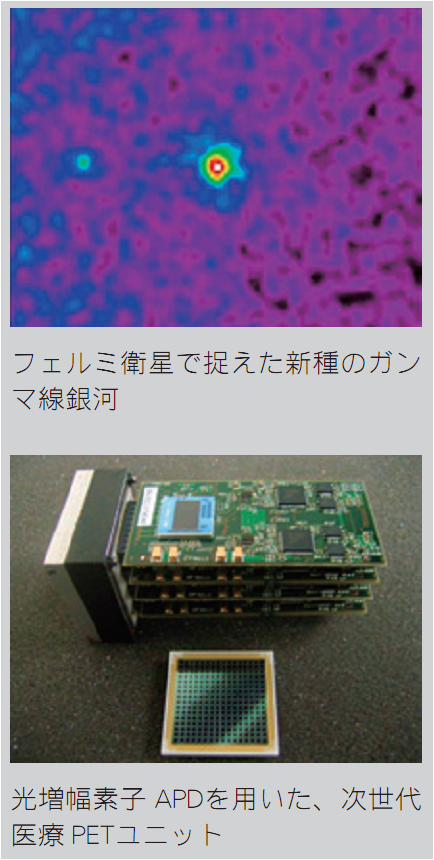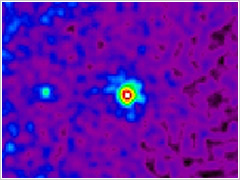
ページ読込中...

ページ読込中...

[English]
| 片岡 淳 [教授] |  |
|
| homepage | https://www.spxg-lab.phys.waseda.ac.jp/ | |
| 専門分野 | 放射線応用物理学研究 | |
| 研究テーマ・研究活動 | ||
| 1995 年 東京大学理学部物理学科卒業 2000 年 東京大学大学院理学系研究科博士課程修了 理学博士 (東京大学) 2000―2001 年 京都大学理学研究科・学振PD 2001 年 東京工業大学大学院理工学研究科・助手 2007 年 東京工業大学大学院理工学研究科・助教 2009 年 早稲田大学理工学部・准教授 2014 年 早稲田大学理工学部・教授 |
||
人間の目で見える光は可視光と呼ばれ、波長が数百ナノメートル(1ナノメートル
は100 万分の1ミリ)の限られた帯域の光です。太陽などの恒星は可視で明るい天体ですが、これより5桁も10 桁も波長が短い(エネルギーが高い)X線やガンマ線でも明るく輝く「謎の」天体たちがいます。
大気に遮られ地上からは見えませんが、衛星や気球を用いれば、激動する宇宙の「生」の姿を捉えることができます。我々の研究室では、2008 年に打ち上げられたフェルミ・ガンマ線宇宙望遠鏡と日本の“すざく” 衛星を駆使した最先端の高エネルギー宇宙観測をおこない、また次期X 線天文衛星Astro-H の装置開発をJAXA、東工大、広島大などと協力しながら進めています。

宇宙に限らず、レントゲン写真や空港の手荷物検査、放射線診断や治療など、日常生活でもX 線・ガンマ線が大きな貢献をしていることをご存知でしょうか?これら最先端の放射線検出器を社会に還元し、より良い人間生活のお役に立てたい、それが我々の次なる願いです。新しい光センサーとして内部増幅機能を持つシリコン半導体素子(APD/MPPC) の開発をすすめ、この分野では世界のトップレベルにあると自負しています。とくに、PET(陽電子断層撮影)と呼ばれるガン診断装置では、従来品より5~ 10 倍も解像度の良い、究極のガンマ線カメラ・ユニットの製作に成功しました。最近では、医療系だけでなく量子情報通信に用いる高感度光センサーの開発などにも着手しています。
我々の研究室は宇宙をベースにしていますが、最先端の物理計測はあらゆる分野・現場で必要とされ、分野の境界がありません。むしろ垣根を取り去った「横断的な」研究室が、ひとつくらいあっても良いのでは?という気持ちで研究を進めています。色々なテーマが混在しつつも新しい検出器の開発と、それを用いた科学に対する興味は共通です。学生同士も大変仲がよく、和気藹々と楽しくやっています。私達と一緒に「垣根を越えた」科学の醍醐味を味わいませんか?
| Jun Kataoka [Professor] |  |
|
| homepage | https://www.spxg-lab.phys.waseda.ac.jp/ | |
| research field | Gamma-ray astronomy, radiological physics, and technology | |
| research keywords | ||
| Gamma-ray astronomy Radiation detector Medical imaging |
||
| link | ||
| Research Profiles (at Faculty of Science and Engineering)Research Profiles (Elsevier SciVal Experts) | ||
Novel semiconductor devices that offer internal multiplication have recently entered wide use in the areas of particle physics, space science, nuclear medicine, and information engineering. We are, in particular, currently developing various photo-detectors, avalanche photodiodes (APDs), and multi-pixel photo-counters (MPPCs) for future applications in medical imaging and space satellite missions. The recent emergence of dual-mobility PET/CT imaging has profoundly affected clinical diagnoses in radiology, oncology, and other areas of nuclear medicine. However, CT exhibits poor soft-tissue contrast and exposes the patient to significant radiation doses that exceed those experienced with PET. The APD is a compact, high-performance light sensor that can be used in MRI-PET to provide ultimate sub-mm spatial resolutions. The very rapid response of MPPC devices will enable future PET detectors with time-of-flight (TOF) capabilities. We are also developing versatile APD- or MPPC-based PET modules for future applications in high-resolution, high-speed medical imaging. APD devices will also be used in the next Japanese X-ray astronomy satellite mission, Astro-H, currently slated for launch in 2013.
A subsequent research topic will involve the study of high-energy phenomena in the universe, including active galactic nuclei (AGNs), binary black-holes, neutron stars, supernova remnants, and gamma-ray bursts. Various modern astronomy satellites are currently used for this research, including the Fermi Gamma-ray Space Telescope (FGST; formerly known as GLAST), Chandra, XMM-Newton, and Suzaku. The successful launch of FGST will provide new opportunities to study gamma-ray emissions from various radio galaxies and galaxy clusters with unprecedented sensitivity. As a full partner of FGST, we currently take the lead for the AGN team in the areas of data analysis, calibration, operations, and software development. In one example, we recently reported on the discovery of a new type of gamma-ray galaxy; this can be found on the NASA website under the title “NASA’s Fermi Finds Gamma-ray Surprises.”(
https://www.nasa.gov/mission_pages/GLAST/news/galaxy_surprise.html)We are also active in analyzing Suzaku data. Recent interests include the unique identification of unidentified Fermi objects (UFOs) as potential “dark accelerators” in the universe.
Gamma-ray radio galaxy NGC 1275 discovered using the Fermi gamma-ray space telescope